Cheers! A doomsday drinking guide
By Thomas Gaulkin | June 9, 2021
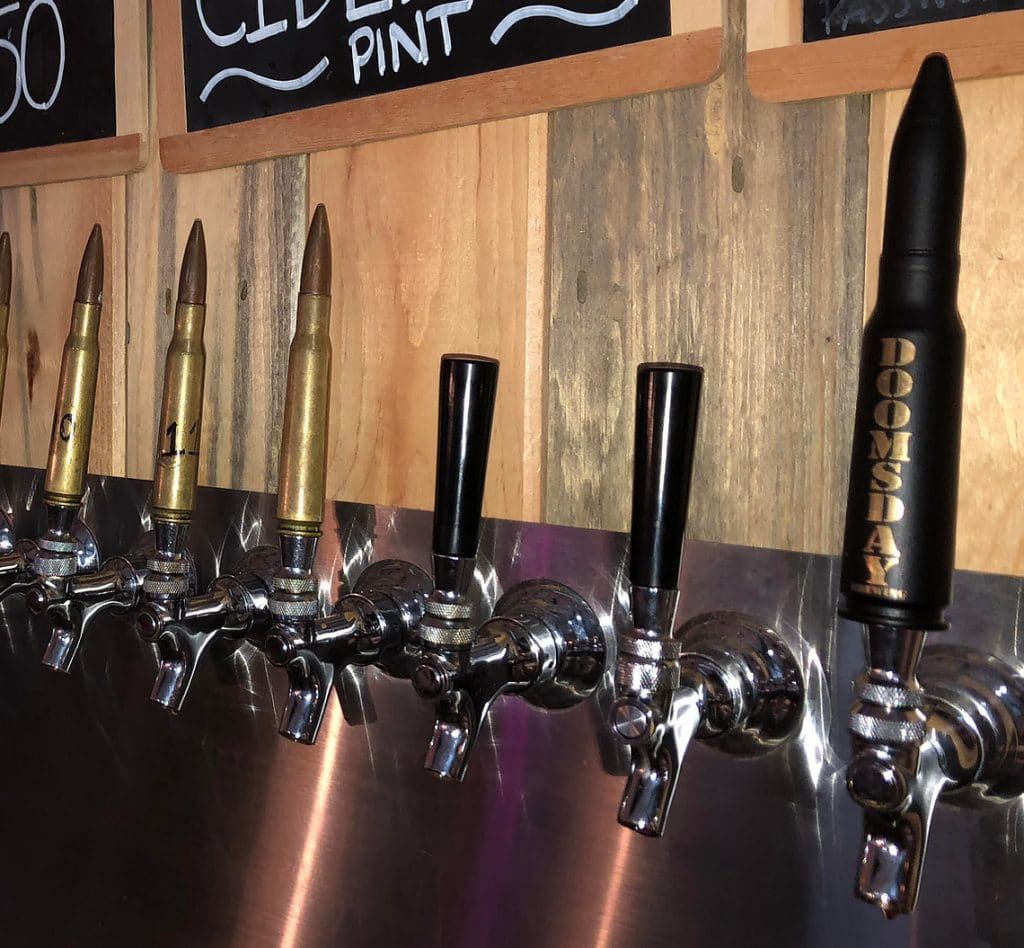 “Doomsday is brewing!” declares Doomsday Brewing, a company with multiple taprooms in Washington state. Brewers around the United States and beyond use nuclear war, climate change, and disruptive technologies to help sell their beverages, some more sincerely than others. Photo: Doomsday Brewing Company
“Doomsday is brewing!” declares Doomsday Brewing, a company with multiple taprooms in Washington state. Brewers around the United States and beyond use nuclear war, climate change, and disruptive technologies to help sell their beverages, some more sincerely than others. Photo: Doomsday Brewing Company
Everyone knows by now that the coronavirus has nothing to do with Mexican beer. But with lockdowns in the US ending and larger outdoor gatherings returning, it’s time for brews, brats, and the country’s next mass summertime epidemiological experiment. So what should people drink?

We at the Bulletin are not opposed to addressing complex threats to humanity while pouring out a cold one. And there are in fact many beers inspired by the global dangers—nuclear weapons, climate change, and an array of disruptive technologies, from killer robots to bioengineering and beyond—that we cover soberly every day. To help quench your existential thirst as sunny days and outdoor activities beckon, here’s a guide to some of the doomiest beers and other drinks to come across our radar screen.
Among the various existentialcohols, atomic-themed beer is the most common. But the nuclear risk cabinet also includes bottles of “Atomik Vodka”—made with grain and water from the Chernobyl exclusion zone—and “Nuke Waste,” a radioactive-green liqueur that looks as terrible as it sounds.
Most brands that go big with words like “atomic” don’t have any real connection to nuclear topics; the word just helps them sound “powerful or modern.”
One fine example, with bold notes of cherry and irony, is Nuclear Wine, which carries the tagline “Exploding the pretensions of wine drinking, one can at a time” but otherwise shows no deeper interest in nuclear affairs. And whoever drinks this cocktail dubbed the Nuclear Reactor will experience powerful things, though none of them is likely to be radioactive:
Beer and nukes go back to the early days of the atomic age (though it all really started with a bottle of chianti). Experiments conducted during the 1955 Operation Teapot series of nuclear weapons tests focused on beer and other beverages. As historian Alex Wellerstein explains, “One of the many lines of investigation during these Civil Defense tests, Project 32.2a, sought to answer a simple question: What will the survivors drink in the post-apocalyptic world? … When the only tool you have is a hammer, all your problems look like nails. The Atomic Energy Commission did what they did best and dropped a nuke on bottles of beer and soda cans.”
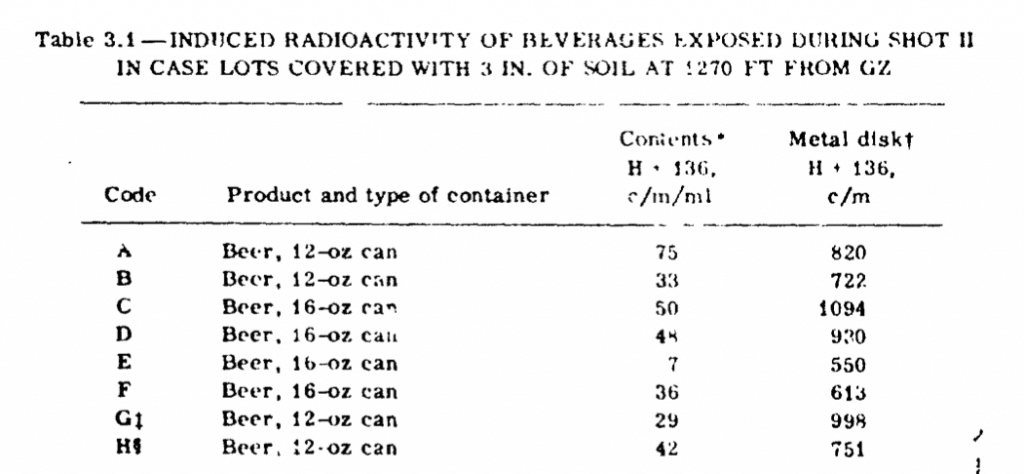
More practical studies since then have led some to make a scientific case for consuming alcohol to combat the effects of radiation. The Department of Energy’s own guidelines for dealing with exposure to tritium—a radioactive by-product of atmospheric nuclear tests and nuclear reactors—suggest that the hydrogen isotope’s average biological half-life of 10 days “can be decreased by simply increasing fluid intake, especially diuretic liquids such as coffee, tea, beer, and wine.” Over the last decade, some studies have also hyped resveratrol, aka the ‘red wine molecule,’ as a tonic against all kinds of disease, including acute radiation syndrome. All the same, the evidence that alcohol helps with exposure to nuclear fission remains inconclusive. Or as one radiation safety expert put it: “Will alcohol help protect against radiation damage, or will it just keep me from caring as much?”
But our job at the Bulletin is, in fact, to care—and look to the future. In that spirit, here’s a sampling of active breweries and distilleries that take the 75-year-old “atomic” alcohol trend further:
Manhattan Project Beer Company. The founders of this decade-old Dallas brewery say their name matches their “creative, collaborative, experimental, and scientific approach to beer making”—but also openly admit to doing it for “the plethora of cool beer names like Half-Life and Superfortress.” Their award-winning flagship brew is called “Hoppenheimer” (American IPA, 7.4 percent alcohol content). But things might turn sour when you see they still have a gose called “Bikini Atoll” (5.2 percent), which sparked heavy criticism of the company a couple of years ago for making light of the ongoing harms caused by nuclear testing on that and other Pacific islands.
Able Baker Brewing Company. This Las Vegas brewpub is named after the first US nuclear tests at Bikini Atoll in 1946, which could also lead to criticism. Able Baker does provide its customers some idea of the story behind their beer names. “The Atomic Age influences our artwork and concepts,” they say, “while allowing us to give a respectful nod to Nevada’s unique state history.” The blurb for a Belgian dark ale called “4,200 Tons” (8.5 percent) explains that the name refers to the uranium purchased from Congo for the initial development of the bomb; “Calutron Girl” (Hefeweizen, 5 percent) is a tribute to the young women recruited to work at the uranium enrichment facility in Oak Ridge, Tenn.; and another Belgian called “The Vela Incident” (11 percent) recounts the still debated case of a “double flash” off the South African coast in 1979 that many believe was a clandestine Israeli nuclear test. The public relations patter: “[T]his beer is dangerously potent and you’ll detect a hidden ‘double-flash’ of flavor as you savor subtle notes of fig and light black pepper.”
Atomic Ale Brewpub. Claiming to be the first brewpub in Washington’s Tri-Cities area, this Atomic Ale is about a 12-minute drive from the site of the first plutonium reactor on the Hanford nuclear production site. The name game here is relatively original— though one might consider staying away from anything called the “Margaritioactive Gose” (4.9 percent).
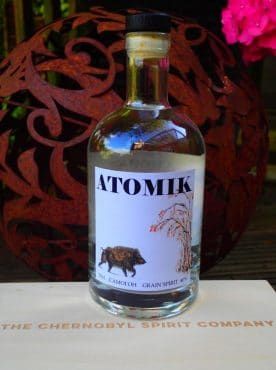
Chernobyl Spirit Company. A group of Ukrainian and UK researchers studying the quality of water and crops in the Chernobyl Exclusion Zone decided to produce a vodka (or grain spirit) using rye that was slightly contaminated with radiostrontium and water from an aquifer about 10 kilometers south of the stricken nuclear power plant. The water they said, was “pure and of high quality, having water chemistry characteristic of a limestone aquifer such as that found in the South of England or the Champagne region of France.” They released their findings along with a bottle labeled “Atomik vodka,” hoping to demonstrate both the lack of harmful radioactivity in the product and the potential land-use and economic benefits the vodka business could provide the local community. Ukraininan regulations prevented further production, so they switched to distilling an apple-based spirit instead, with trees from a region further from the reactor but still in a contamination zone. This month the group said it had 1,500 bottles of the new alcohol ready to sell in Ukraine and the UK, but these were again blocked by Ukrainian authorities.
Compared with the atomic aesthetic, climate change seems a harder sell at the liquor store. For one thing, alcohol production is itself contributing to carbon emissions and global warming. “As a rule of thumb, the higher the alcoholic content of a drink, the higher the carbon footprint per liter – so beer is lower than wine, which is lower than spirits,” Tom Cumberlege, associate director of corporate carbon measuring company Carbon Trust, told Vice.
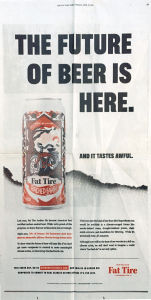
Sustainable growing and manufacturing practices are increasingly commonplace at many breweries and vineyards, but identifying a product with global warming right on the label is probably never going to be particularly lucrative. That said, here are a couple of breweries that not only put climate change on the label; they actually brewed it into the beer:
New Belgium: “Torched Earth.” Colorado-based brewer New Belgium is well-known for its Fat Tire amber ale and eco-friendliness. Last month the brewery took out a full-page ad in the New York Times to tout a deliberately bad post-Apocalyptic amber it calls “Torched Earth” (5.2 percent alcohol). “We brewed the future of beer… and it tastes awful,” the ad proclaimed, before directing people to a special website that explains the project further: “This beer uses the kind of ingredients that would be available in a climate-ravaged future including: smoke-tainted water, drought-resistant grains, shelf-stable extracts and dandelion weeds. While it’s technically beer, it’s not great.”
BrewDog: “Make Earth Great Again.” Scotland-based BrewDog released its “Make Earth Great Again” saison (7.5 percent) during the Trump presidency: “From the moment America decided to withdraw from the Paris Accord our planet has been on the clock.” (We agree!) Like New Belgium’s awful brew, the concept was to make a beer using ingredients connected with climate change. But instead of imagining what the leftovers would be after the planet overheats, BrewDog’s recipe features ingredients “from areas of the world most affected by our changing planet… water from melted Polar ice caps and cloudberries from the threatened Arctic.” The choice of a saison style beer was, according to the brewers, because it is the “warmest fermenting beer style available.” As the video below shows, BrewDog’s marketing tactics aren’t quite as sophisticated as New Belgium’s, but they make a good point all the same: “Whether you work in a brewhouse or the White House, standing up to climate change is everyone’s responsibility.”
It’s challenging to find prominent makers of alcohol hawking booze via the various other disruptive human-made threats that the Bulletin covers.
But sometimes they do, in creative and unusual ways.
With global COVID-19 lockdowns causing an increase in remote work and alcohol consumption, a New Hampshire brewery launched a series of beers to help accommodate both at once. The “‘Working’ From Home” series of ales by Throwback Brewery features “I Was On Mute” (2.6 percent alcohol; “pairs well with conference calls, sweatpants, and homeschooling”) and “Reply All?!” (a near non-alcoholic and Zoom-friendly 0.92 percent).
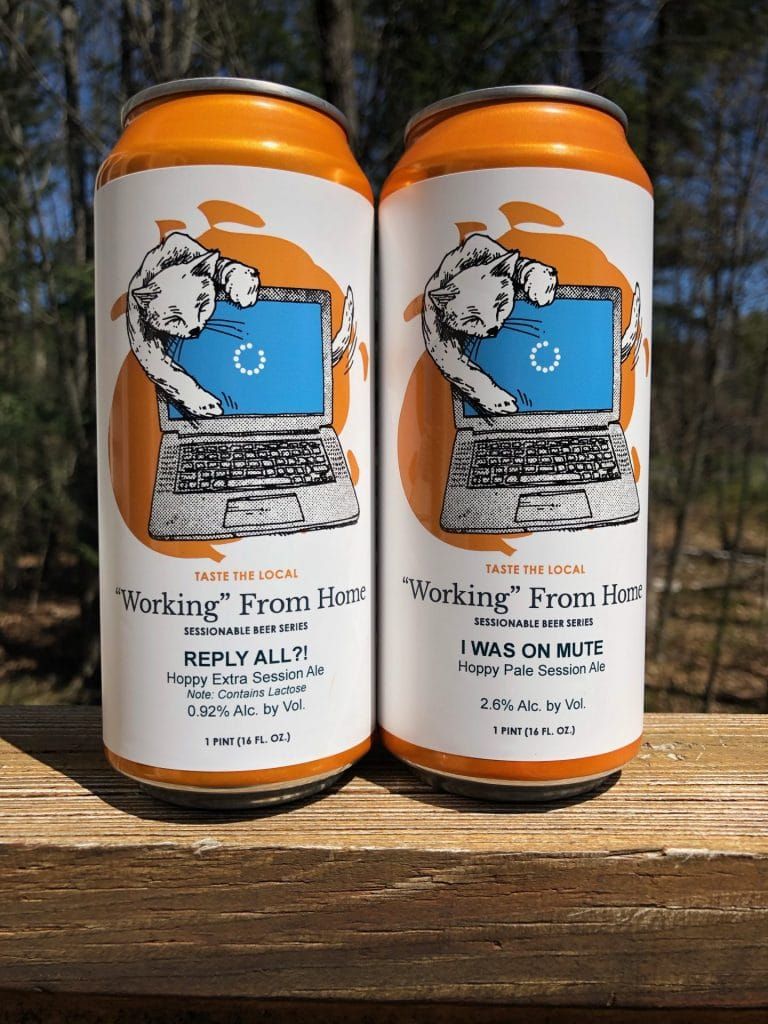
Meanwhile, the aforementioned Brewdog brewery announced its own pandemic-friendly service that delivers beer by drone:
In July, we will start using drones to make socially distanced beer deliveries to various locations on our 42 acre Columbus campus.
And we are exploring using drones as the next stage of our BrewDog Now delivery service here in the UK. pic.twitter.com/U9frjwfRYt
— BrewDog (@BrewDog) June 16, 2020
And how about brewing beer by drone? In Philadelphia, Dock Street Brewing released a pale ale called “Swarm Intelligence”—“brewed in collaboration with our human and non-human neighbors”—that used drones to drop hops into its fermenting tanks.
Machines that replace humans are the undeniable theme of North Carolina’s Wooden Robot Brewery, which produces a sour farmhouse ale called Universal Automation and Godless Killing Machine imperial stout. But the most ominously threatening stout, no doubt, is Kill All Humans. At a somewhat insidious 6.2 percent alcohol content, the brewers call it “[t]he perfect comfort beer for when the robot revolution comes for all of us!”
If after drinking Kill All Humans you feel the need to reassert human control, you could watch this highlight reel of seemingly inebriated robots at a DARPA competition a few years back:
Do you have a favorite doomsday drink? Let us know in the comments below…
Together, we make the world safer.
The Bulletin elevates expert voices above the noise. But as an independent nonprofit organization, our operations depend on the support of readers like you. Help us continue to deliver quality journalism that holds leaders accountable. Your support of our work at any level is important. In return, we promise our coverage will be understandable, influential, vigilant, solution-oriented, and fair-minded. Together we can make a difference.
Keywords: beer, doomsday
Topics: Climate Change, Disruptive Technologies, Nuclear Risk














